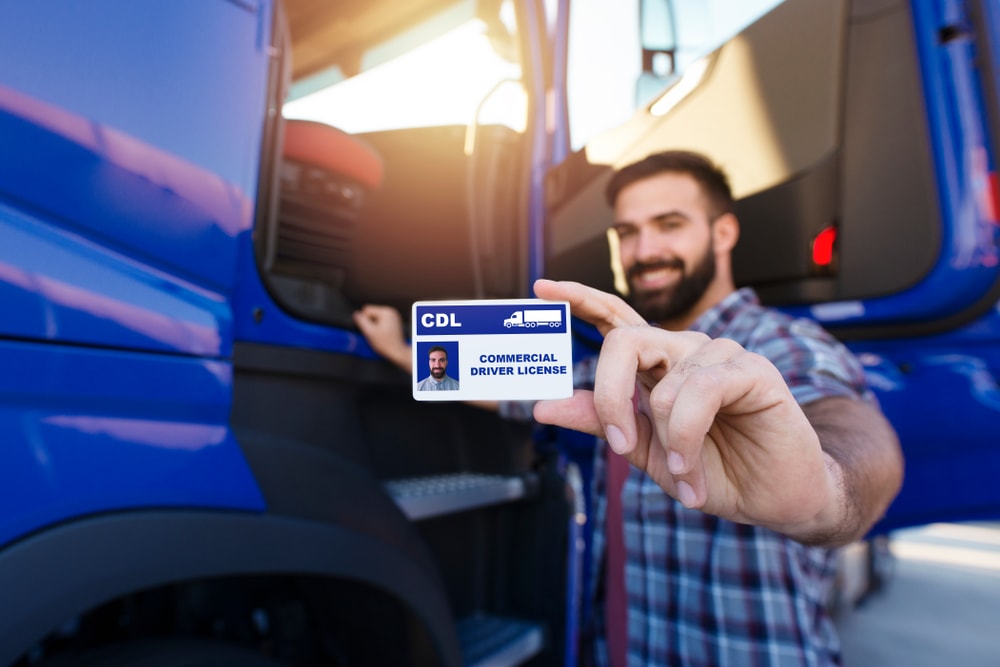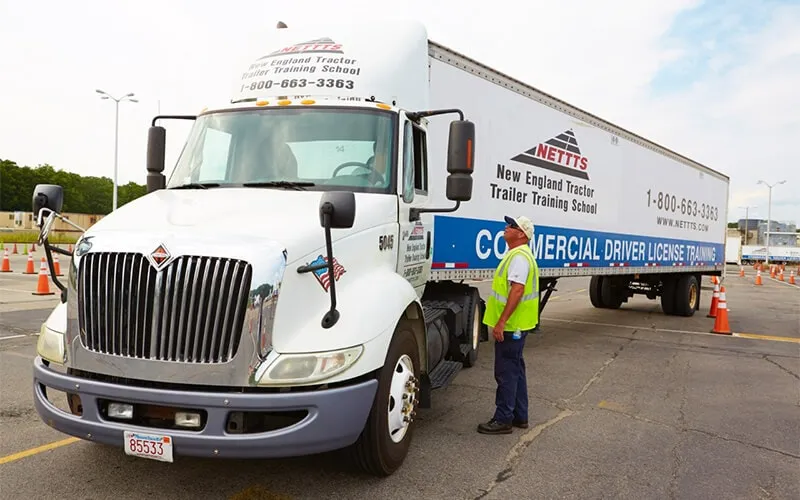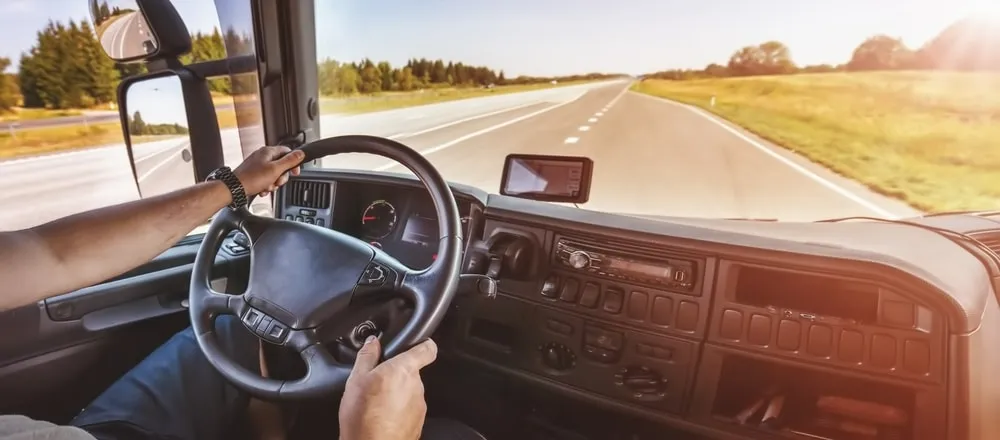
If you’re looking to become a commercial driver, understanding the CDL requirements is crucial. This guide will walk you through everything you need to qualify for a CDL, from age and residency prerequisites to medical exams, permit processes, and skills tests.
Table Of Contents
Key Takeaways
- To obtain a Commercial Driver’s License (CDL), applicants must meet age, residency, medical qualifications, and pass specific knowledge and skills tests to ensure road safety.
- Acquiring a Commercial Learner’s Permit (CLP) is the first step toward obtaining a CDL, allowing candidates to practice driving under supervision and requiring a minimum holding period before taking the CDL skills test.
- Entry-Level Driver Training (ELDT) is mandatory for new CDL applicants, ensuring they receive comprehensive training on vehicle operation and safety, and must be completed through registered training providers.
- CDL Training is mandatory and school selection is an important part of the process
Defining a Commercial Motor Vehicle (CMV)

Understanding what qualifies as a commercial motor vehicle (CMV) is crucial for obtaining a CDL. Generally, a CMV is a vehicle that weighs over 10,000 pounds when fully loaded, which is often related to its gross combination weight rating. This weight threshold ensures regulation under CDL guidelines for commercial motor vehicles requiring specialized skills and knowledge. It’s a crucial distinction that separates light personal vehicles from those that require professional handling.
But weight is not the only factor. Vehicles designed to transport 16 or more passengers, including the driver, also fall under the CMV category. This includes buses and large vans used for public transportation or private charters. Additionally, any vehicle transporting hazardous materials, regardless of its weight, is considered a CMV. These vehicles pose significant risks, and thus, require drivers to have specialized knowledge and endorsements.
These classifications clarify why certain vehicles require a CDL. Driving a heavy truck, a passenger bus, or a vehicle transporting hazardous materials involves substantial skills and responsibilities. This foundational knowledge sets the stage for understanding why the CDL process is as rigorous as it is.
Basic CDL Requirements

Before you can get behind the wheel of a commercial motor vehicle, there are several basic requirements you must meet. These include age and residency requirements, medical qualifications, and passing specific knowledge and skills tests. Meeting these criteria grants CDLs only to qualified individuals, maintaining road safety and professionalism.
The knowledge tests assess your understanding of commercial driving rules and regulations. The skills test evaluates your ability to operate a CMV safely and effectively. These tests are essential in ensuring that all commercial drivers are competent and prepared for road challenges.
Age and Residency
To apply for a CDL, you must meet specific age and residency criteria. The minimum age requirement to hold a CDL is 18 years. However, if you plan to drive a commercial motor vehicle across state lines or transport hazardous materials, you must be at least 21 years old. This age requirement ensures drivers have the maturity and experience to handle interstate commerce and hazardous materials transportation.
Proof of legal residency or citizenship is mandatory for all CDL applicants, including documents that verify your name and residency when applying for a Commercial Learner’s Permit (CLP). These requirements maintain the integrity of the CDL system and ensure all drivers are legally eligible to operate commercial vehicles.
Medical Qualifications
Medical qualifications are essential for obtaining a CDL. All CDL applicants must pass a Department of Transportation (DOT) physical examination, valid for up to 24 months. This examination ensures that drivers are physically capable of handling the demands of operating a commercial motor vehicle. The DOT physical includes tests for vision, hearing, and overall health.
A Medical Examiner’s Certificate confirms that you meet the necessary health standards. Drivers must have corrected vision of at least 20/40 in each eye. Additionally, individuals with insulin-dependent diabetes or certain cardiovascular conditions may face restrictions or require additional documentation.
These stringent medical requirements ensure all commercial drivers are fit to operate their vehicles safely.
Obtaining a Commercial Learner’s Permit (CLP)
The first significant step towards obtaining your CDL is acquiring a Commercial Learner’s Permit (CLP). This permit allows you to practice driving on public roads with a qualified CDL holder present. Before applying for a CLP, review your driving record for the past 10 years to ensure there are no disqualifying offenses. This initial step lays a solid foundation for your commercial driving career.
You must hold the CLP for at least 14 days before taking the CDL skills test. This waiting period ensures you have ample time to practice and become comfortable with the vehicle you intend to drive. The CLP allows you to gain the practical experience necessary for passing the skills test and becoming a competent commercial driver.
Knowledge Test Preparation
Preparing for the knowledge tests required for a CLP is essential. These tests evaluate your understanding of the rules and regulations governing commercial driving. Passing the general knowledge test, among others, is required to obtain your permit. Arrive 15 minutes early and bring all required documents, including your medical certification, for a smooth testing experience.
The knowledge tests cover a wide range of topics, from basic driving rules to specific regulations related to commercial driving. Thorough preparation is key to passing these tests. Using study guides, taking practice tests, and attending preparatory courses can significantly enhance your chances of success.
Documentation and Fees
When applying for a CLP, you must provide various documents to verify your identity and social security number. Proof of identity is crucial to ensure that the permit is issued to the correct individual. Additionally, there is a nonrefundable application fee that must be paid when you submit your application. Knowing the required documents and fees streamlines the application process and avoids unnecessary delays.
Being prepared with the necessary documentation and understanding the associated costs makes obtaining your CLP much smoother. This preparation ensures that you can focus on the critical task of learning and practicing your driving skills.
Entry-Level Driver Training (ELDT)

Entry-Level Driver Training (ELDT) is a requirement for new CDL applicants. All individuals seeking a commercial driver’s license must complete this training. These federal regulations set standards for the training that must be completed before taking the CDL skills or knowledge tests. ELDT ensures that all new drivers receive comprehensive training that covers both theoretical knowledge and practical skills specific to the type of vehicle they intend to operate.
Applicants for a Class A or Class B CDL who received their CLP after February 7, 2022, must undergo ELDT. This training covers vehicle inspections, basic vehicle control, and driving in various conditions. Completing ELDT prepares you for the challenges of commercial driving and ensures you have the necessary skills to operate a CMV safely.
Registered Training Providers
Only training providers listed on the Training Provider Registry (TPR) are authorized to deliver ELDT. Accessing the TPR is generally free and helps individuals find approved training providers that meet federal standards. A registered training provider guarantees you receive the proper training required to obtain your CDL.
Choosing the right training provider is a crucial decision in your journey to becoming a commercial driver. Using the TPR helps you find reputable providers offering quality training programs tailored to your specific needs.
Training Curriculum
The ELDT curriculum includes both theory and behind-the-wheel training specific to the vehicle type you plan to operate. After completing your training, your provider submits your certification to the Training Provider Registry electronically. This ensures that your training is documented and recognized by the relevant authorities.
The curriculum covers essential topics such as vehicle inspections, basic control skills, and driving in various conditions. Completing this comprehensive training is essential for passing the CDL skills test and becoming a competent commercial driver.
Passing the Skills Test

The skills test is a critical step in obtaining your CDL. It consists of three main components: a pre-trip inspection, a basic control skills evaluation, and an on-road driving assessment. Each part of the test evaluates different aspects of your ability to operate a CMV safely and effectively.
Thorough preparation for the skills test is essential. Practicing the maneuvers and understanding the test criteria can significantly increase your chances of success. Passing the skills test demonstrates your competence and readiness to handle the responsibilities of a commercial driver.
Scheduling the Skills Test
Contact your local DMV or a third-party testing center to find available dates and times for your skills test. Appointments can typically be made online using your driver’s license number and personal information.
Booking in advance secures a suitable date and allows ample preparation time.
Components of the Skills Test
The skills test consists of three components: the Vehicle Inspection Test, the Basic Controls Test, and the Road Test. The Vehicle Inspection Test requires you to identify and explain vehicle components without crawling under the vehicle. The Basic Controls Test involves performing three backing maneuvers: straight line, offset, and alley dock backing. The Road Test assesses your ability to drive in real traffic scenarios, including turning, lane changes, and stopping.
Practicing and understanding these components are key to passing the skills test. Each part evaluates different skills necessary for safe and effective commercial driving.
Special Endorsements and Restrictions
In addition to the basic CDL, there are special endorsements and restrictions that may apply. These endorsements are required for specific types of driving, such as transporting hazardous materials or operating a tanker. Obtaining the necessary endorsements ensures you are qualified for your specific commercial driving needs.
Be aware of common restrictions that may limit your driving capabilities. These can include intrastate-only driving or limitations on air brake usage. Knowing these restrictions helps you understand any limitations on your CDL and plan your career accordingly.
Hazardous Materials (HazMat) Endorsement
A HazMat endorsement is necessary for CDL holders transporting hazardous materials. To obtain this endorsement, you must complete a TSA security threat assessment, which evaluates you for any security risks associated with transporting hazardous materials.
This endorsement ensures only qualified and vetted individuals transport hazardous materials.
Other Endorsements
Other endorsements include the tanker endorsement for transporting liquids in bulk and the passenger endorsement for operating vehicles designed to carry 16 or more individuals, including the driver. These endorsements require additional testing and qualifications to ensure competency in handling specific types of commercial driving.
Common Restrictions
Common restrictions for CDL holders include limitations on intrastate-only driving, which applies to drivers under 21 or those certified as non-excepted intrastate. Other restrictions may include air brake limitations, requiring specific endorsements to operate vehicles with air brakes and a commercial driver license cdl, as well as commercial driver licenses.
Understanding these restrictions is essential for planning your commercial driving career.
Maintaining Your CDL

Keeping an active CDL is essential for continuing your career as a commercial driver. Renew your CDL every five years, typically on your birthday. Keeping your CDL active ensures eligibility to operate commercial vehicles and comply with regulatory requirements.
Maintaining a clean driving record is crucial. Traffic violations can lead to penalties, including suspension of your CDL. A clean driving record demonstrates your commitment to safety and professionalism on the road.
Renewal Process
Renewing your CDL involves a few key steps. In California, for example, you must visit a DMV office in person and complete specific application forms. For online renewal eligibility, maintain a clean driving record and avoid having a hazardous materials endorsement. If your license has been expired for over 60 days, you may need to pass a written test covering traffic laws.
Preparation is crucial for the renewal process. Know your CDL’s expiration date and plan ahead to avoid work interruptions. Up-to-date documentation and understanding renewal requirements will help maintain your CDL’s validity.
Keeping a Clean Driving Record
A clean driving record is essential for maintaining your CDL. Violations can lead to penalties, including license suspension. Serious traffic violations, such as driving under the influence or reckless driving, can result in immediate CDL disqualification. Accumulating multiple minor traffic tickets within a short timeframe can jeopardize your CDL status.
A clean driving record is vital for your CDL and reflects your commitment to road safety. It ensures eligibility for various endorsements and allows you to utilize online renewal applications without complications. Vigilance about traffic laws and practicing safe driving habits will help protect your CDL and career.
Summary
Navigating the path to obtaining and maintaining a Commercial Driver’s License (CDL) involves several critical steps and requirements. From understanding what constitutes a commercial motor vehicle (CMV) to meeting age, residency, and medical qualifications, each step is designed to ensure that only qualified individuals are granted a CDL. Obtaining a Commercial Learner’s Permit (CLP) and completing Entry-Level Driver Training (ELDT) are essential milestones on this journey.
Special endorsements and understanding common restrictions further tailor your CDL to specific types of commercial driving. Maintaining your CDL requires staying on top of renewal processes and keeping a clean driving record. By following these guidelines and preparing thoroughly, you can embark on a successful career in commercial driving, enjoying the opportunities and freedom it offers.
Frequently Asked Questions
What is the minimum age requirement for obtaining a CDL?
The minimum age requirement to obtain a Commercial Driver’s License (CDL) is 18 years for intrastate driving and 21 years for interstate driving or transporting hazardous materials.
What medical qualifications are needed for a CDL?
To obtain a CDL, you must pass a DOT physical examination, secure a Medical Examiner’s Certificate, and meet required vision and health standards. These qualifications ensure that you are fit to operate commercial vehicles safely.
How long must I hold a Commercial Learner’s Permit (CLP) before taking the CDL skills test?
You must hold a Commercial Learner’s Permit (CLP) for at least 14 days before you are eligible to take the CDL skills test. This requirement ensures you have sufficient time to practice and prepare.
What is Entry-Level Driver Training (ELDT)?
Entry-Level Driver Training (ELDT) is a required program that encompasses both theoretical and practical behind-the-wheel instruction, which must be completed prior to taking the CDL skills or knowledge tests.
How can I maintain my CDL?
To maintain your CDL, it is essential to renew it every five years, maintain a clean driving record, and comply with any specific renewal requirements. Adhering to these guidelines will ensure your license remains valid and reflects your commitment to safe driving.

